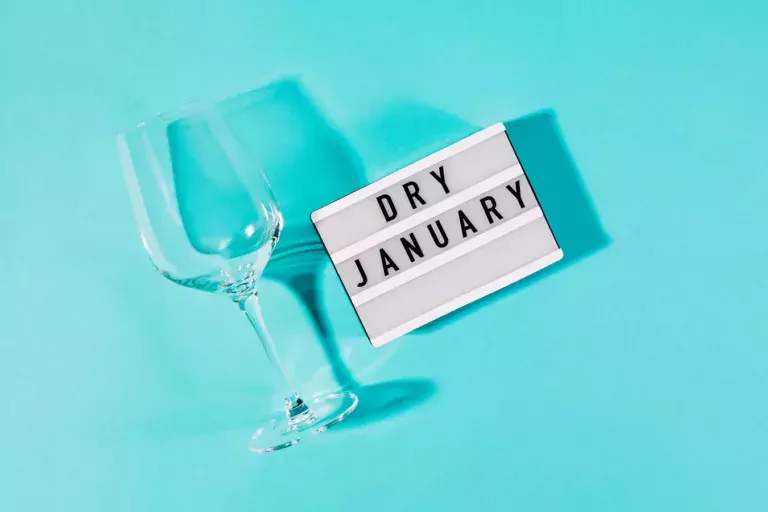Are you participating in Dryuary (or Dry January) this year? If so, you have plenty of company! This month-long observation, in which people commit to abstaining from alcohol during January, originally started as a public health campaign in the UK in 2013. It has since grown in popularity and become a world-wide phenomenon, with millions of people participating every year. Similar events are now sprinkled throughout the calendar, including Sober October, Sober Spring, and Dry July.
There are a few converging phenomena playing into this. During the pandemic, we heard a lot about a pretty dramatic increase in alcohol consumption, especially by women. I think a lot of people emerged from lockdown feeling like their drinking had gotten a little out of control and were looking for a way to ratchet things down.
Researchers have also been questioning long-standing guidance on what constitutes safe or low risk alcohol consumption. Some have argued that any amount of alcohol increases your risk. Others point out that it is not a one-size-fits-all equation. Even as we speak, recommendations to update official guidance are being hotly debated, both here in the U.S. and in neighboring Canada. But there does seem to be an emerging consensus that previous recommendations (no more than 1 drink a day for women, 2 drinks a day for men) may be a little too high.
See also:
The Sober Curious Movement: Examining Generational Trends
But I’m sure you have also noticed a rise in the so-called Sober Curious movement, with more and more people experimenting with an alcohol-free lifestyle, either for a specific period of time or as a permanent choice. There’s definitely a generational factor as well, with Millennials and Gen Z tending to drink a lot less than Gen X and the Boomers.
Dry January Benefits: A Breakdown of Health Improvements
Proponents of Dryuary point out that even a short break from alcohol can yield significant health benefits, especially if you are someone who drinks daily or near daily. Going a month without alcohol can improve the health of your liver and heart, reduce your cancer risk, and improve your sleep. Depending on how much you typically drink, you may also notice an improvement in your mood, the way your skin looks, your ability to concentrate and focus, and even modest weight loss.
You might also like my take on how alcohol is metabolized.
Dry January as an Opportunity for Personal Reflection
But Dryuary is also an opportunity to reassess your drinking behaviors, allowing you to see your own patterns and triggers more clearly, and question some of your beliefs about what’s required for you to feel relaxed or entertained. Many of us, for example, have gotten into the habit of using alcohol to cope with stress or boredom. And, obviously, there are more productive ways to deal with those challenges.
Rethinking Drinking: Shifting Perspectives on Alcohol Consumption
Researchers have also been questioning long-standing guidance on what constitutes safe or low-risk alcohol consumption. Some have argued that any amount of alcohol increases your risk. Others point out that it is not a one-size-fits-all equation. Even as we speak, recommendations to update official guidance are being hotly debated, both here in the U.S. and in neighboring Canada. But there does seem to be an emerging consensus that previous recommendations (no more than 1 drink a day for women, 2 drinks a day for men) may be a little too high.
Some Potential Pitfalls and Considerations
Although observing Dryuary can definitely be beneficial, there are also a few potential unintended consequences.
Withdrawal Risks and Seeking Support
For heavy/dependent drinkers, abruptly stopping drinking could cause severe withdrawal symptoms like seizures. That’s not to say that people with a physical dependence on alcohol shouldn’t try to stop drinking. But they may need medical support. If you have any concerns about whether you might have a physical dependence, I encourage you to speak to your doctor.
Black and White Thinking: Navigating the Gray Areas
Another concern with Dryuary is that it risks setting up black and white thinking about alcohol consumption. If you end up drinking once during January, you may be tempted to abandon the effort altogether. But it is not necessary to be 100% alcohol free to get a lot of benefit. Even if your Dryuary ends up being a Dampuary, there is still a lot to be gained – and learned – from taking a break from your usual consumption patterns.
Overcompensation Risks: Ensuring a Balanced Approach
Finally, there could be a risk of overcompensation, where someone feels entitled to drink more heavily after successfully completing Dryuary or another extended break. That is definitely not the point. Ideally, your Dryuary experience can fuel healthier and more mindful drinking habits going forward.
Tips for a Beneficial and Enjoyable Dry January
With that in mind, here are some tips on making your Dryuary as beneficial and enjoyable as possible:
- Tell friends and family you’re doing Dry January and ask them to support you.
- Join an online community for inspiration and camaraderie.
- Download a free app like Try Dry to track your progress and get motivated.
- Keep a journal to explore what you’re noticing about your urges to drink.
- Stock up on appealing non-alcoholic drinks so you don’t feel deprived.
- Avoid potentially tempting or triggering situations like happy hours.
- Be gentle with yourself if you slip up. Get back on track the next day rather than giving up entirely.
- Take some time to plan your re-entry before you get to the end of the month. Do you want to reintegrate alcohol into your life when the month is over? How do you want that to look? What might it take to make that happen?
If you are participating in Dryuary this year–whether for the first time or the tenth–I’m interested to hear how it goes for you. You can email me at nutrition@quickanddirtytips.comcreate new email or leave me a message at 443-961-6206.




